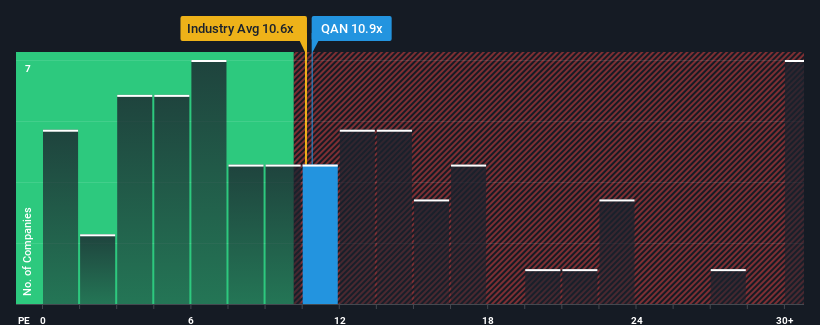Cautious Investors Not Rewarding Qantas Airways Limited's (ASX:QAN) Performance Completely
When close to half the companies in Australia have price-to-earnings ratios (or "P/E's") above 20x, you may consider Qantas Airways Limited (ASX:QAN) as an attractive investment with its 10.9x P/E ratio. However, the P/E might be low for a reason and it requires further investigation to determine if it's justified.
While the market has experienced earnings growth lately, Qantas Airways' earnings have gone into reverse gear, which is not great. It seems that many are expecting the dour earnings performance to persist, which has repressed the P/E. If you still like the company, you'd be hoping this isn't the case so that you could potentially pick up some stock while it's out of favour.
See our latest analysis for Qantas Airways

What Are Growth Metrics Telling Us About The Low P/E?
There's an inherent assumption that a company should underperform the market for P/E ratios like Qantas Airways' to be considered reasonable.
Retrospectively, the last year delivered a frustrating 21% decrease to the company's bottom line. Unfortunately, that's brought it right back to where it started three years ago with EPS growth being virtually non-existent overall during that time. Therefore, it's fair to say that earnings growth has been inconsistent recently for the company.
Shifting to the future, estimates from the analysts covering the company suggest earnings should grow by 19% each year over the next three years. Meanwhile, the rest of the market is forecast to expand by 17% per year, which is not materially different.
In light of this, it's peculiar that Qantas Airways' P/E sits below the majority of other companies. It may be that most investors are not convinced the company can achieve future growth expectations.
The Key Takeaway
Using the price-to-earnings ratio alone to determine if you should sell your stock isn't sensible, however it can be a practical guide to the company's future prospects.
We've established that Qantas Airways currently trades on a lower than expected P/E since its forecast growth is in line with the wider market. When we see an average earnings outlook with market-like growth, we assume potential risks are what might be placing pressure on the P/E ratio. At least the risk of a price drop looks to be subdued, but investors seem to think future earnings could see some volatility.
There are also other vital risk factors to consider and we've discovered 3 warning signs for Qantas Airways (1 is potentially serious!) that you should be aware of before investing here.
If you're unsure about the strength of Qantas Airways' business, why not explore our interactive list of stocks with solid business fundamentals for some other companies you may have missed.
Valuation is complex, but we're here to simplify it.
Discover if Qantas Airways might be undervalued or overvalued with our detailed analysis, featuring fair value estimates, potential risks, dividends, insider trades, and its financial condition.
Access Free AnalysisHave feedback on this article? Concerned about the content? Get in touch with us directly. Alternatively, email editorial-team (at) simplywallst.com.
This article by Simply Wall St is general in nature. We provide commentary based on historical data and analyst forecasts only using an unbiased methodology and our articles are not intended to be financial advice. It does not constitute a recommendation to buy or sell any stock, and does not take account of your objectives, or your financial situation. We aim to bring you long-term focused analysis driven by fundamental data. Note that our analysis may not factor in the latest price-sensitive company announcements or qualitative material. Simply Wall St has no position in any stocks mentioned.
About ASX:QAN
Qantas Airways
Provides air transportation services in Australia and internationally.
Good value with slight risk.
Similar Companies
Market Insights
Community Narratives




